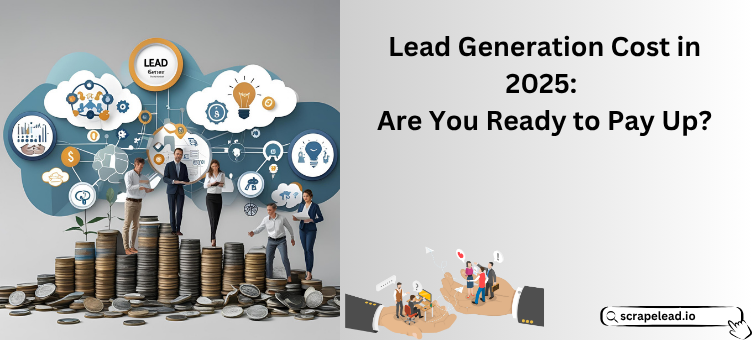
Lead Generation Cost in 2025: Are You Ready to Pay Up?
Let me ask you one simple question:
If you want to keep your body active and healthy, then what do you need?
Obviously, proper oxygen, food, and water, right?
Now think about your business.
If you want to keep your business active, healthy, and growing, then what does it need?
The answer is: LEAD GENERATION.
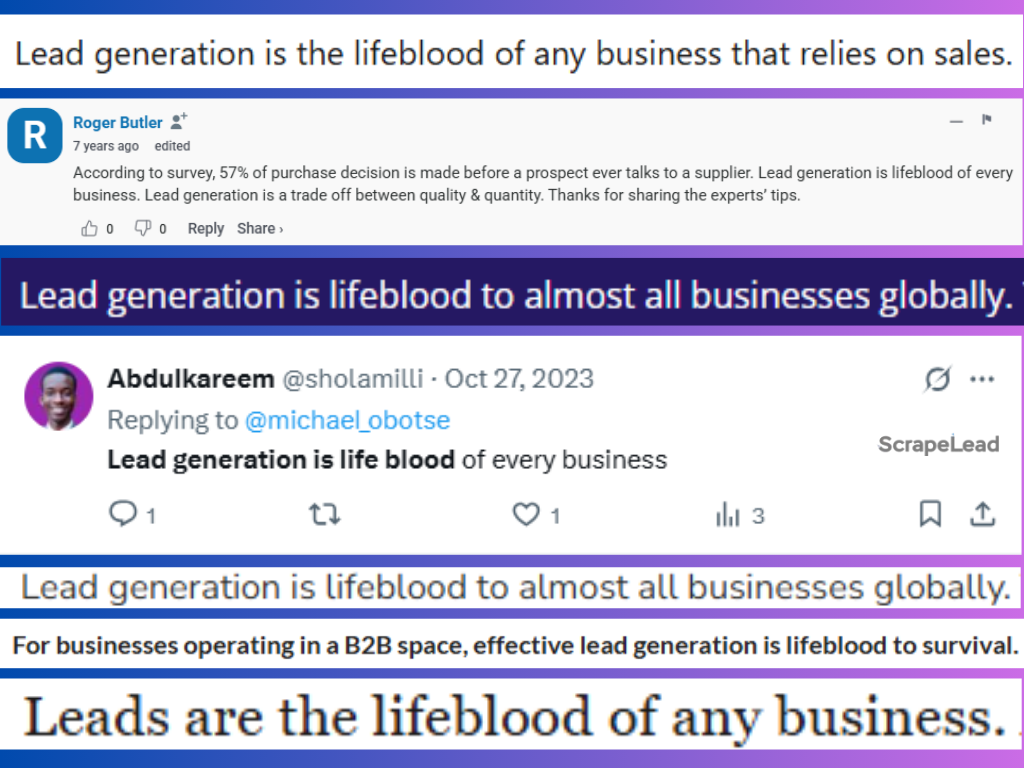
Why? Because,
- No leads means no sales
- No sales means no money
- No money means no honey (just kidding 😂)
But here’s the real question:

Well, the lead generation cost depends on:
- Your industry
- The channels you’re using
- Your goals
- And whether you’re handling it in-house, outsourcing to agencies, or using lead-gen software.
But don’t worry, we’ll break down everything related to the cost of lead generation.
So, stay tuned to the end, and let’s start with the basics first.
What is Lead Generation?
In very simple terms, lead generation is the process of turning strangers into potential customers.
You can do this through many channels, such as:
- Content marketing
- Paid advertising
- Email marketing
- SEO and organic traffic
- Cold outreach
- Events and webinars
- Referrals and partnerships
How Much Does Lead Cost?
As we told you, lead generation cost depends on the methods you use and the scale of your efforts.
Some businesses manage everything in-house, while others outsource to agencies or use special lead-gen software to generate leads.
Here’s a simple breakdown of the typical costs:
In-House Team
If you’re building your own lead gen team, then you’ll need to:
- Pay salaries of marketing/sales staff
- Invest in CRM software and marketing tools
- Pay the rent for your office space and admin expenses
The good thing: You have full control, and your team will know your brand inside and out.
The bad thing: It’s too costly for small businesses.
Estimated monthly cost: $5,000 – $15,000+ (depending on team size and tools)
Outsourced Services/Agency:
Many companies hire lead generation agencies on a monthly basis or on a pay-per-lead basis.
Agencies may offer:
- Done-for-you ad campaigns
- Cold email outreach
- Appointment setting
- SEO and content marketing
- Lead list building
Small businesses often pay a few hundred or a few thousand dollars per month for basic services, while larger companies may invest $4,000 – $20,000+ each month.
(The cost depends on which services you choose for your company.)
But this gives you flexibility and expertise without hiring full-time staff.
Using Lead Gen Tools and Software
If you want to generate leads on your own, you can also use lead gen tools and software.
Basic email or CRM tools can start as low as $10 to $30 per month. (But you’ll only get a small number of contacts.)
If you want to use more advanced tools like HubSpot, it starts around $800/month.
Enterprise-level tools can go into the thousands.
Some B2B lead tools charge per month or even per lead. (Usually anywhere from $20 to $100+.)
If you go with a fully managed software solution, then expect to pay between $900 and $10,000 or more per month.
Remember: The bigger you grow, the more you’ll need to spend on tools.
What is Cost Per Lead?
Cost Per Lead (CPL) means how much money you spend to get one person to show interest in what you’re offering.
How to Calculate Cost Per Lead?
You can calculate the cost per lead using the following formula:

For example:

You can also use a CPL calculator to calculate your cost per lead.
Average Cost Per Lead by Industry
The cost per lead can be very different depending on the industry.
| Industry | Cost Per Lead by Industry |
|---|---|
| Higher Education | $50 - $985 |
| Financial Services | $155 - $655 |
| Legal Services | $510 - $650 |
| Oil & Gas | $500 - $630 |
| Software Development | $505 - $595 |
| Transportation & Logistics | $500 - $590 |
| Manufacturing | $410 - $555 |
| IT & Managed Services | $380 - $505 |
| Staffing & Recruiting | $475 - $500 |
| Industrial IOT | $400 - $500 |
| Fintech | $410 - $455 |
| Real Estate | $420 - $450 |
| Business Insurance | $390 - $425 |
| Cybersecurity | $400 - $410 |
| PCB Design & Manufacturing | $270 - $380 |
| Aerospace & Aviation | $275 - $375 |
| Healthcare | $160 - $365 |
| Engineering | $200 - $290 |
| Automotive | $270 - $285 |
| Environmental Services | $205 - $280 |
| Hotels & Resorts | $220 - $270 |
| Biotech | $235 - $255 |
| B2B SaaS | $160 - $240 |
| Construction | $170 - $230 |
| Technology | $205 - $215 |
| Solar | $195 - $210 |
| Pharmaceutical | $120 - $135 |
| Entertainment | $110 - $120 |
| HVAC | $70 - $110 |
| Travel & Tourism | $100 - $105 |
| Marketing | $95 - $100 |
| E-commerce | $80 - $100 |
| Telecom | $40 - $50 |
| Retails | $30 - $35 |
| Non-profits | $30 - $35 |
(Sources: FirstPageSage, Congnism, emailtooltester)
In summary, the B2B cost per lead is higher than B2C.
(These figures can fluctuate based on campaign strategy, targeting, and geographic location.)
Also, note that most of the data we have is from the United States, but similar patterns show up around the world.
According to a 2025 report, the average cost per lead in the United States is about $198.
That report also noted wide variation, like:
- Around 9% of companies pay $10 or less per lead
- And around 4% of companies pay $1,000 or more per lead
In the UK or Europe, the costs are usually about the same, just in pounds or euros.
For example, the cost of the LinkedIn ads in the UK is around £3 – £4 per click (about $4 – $5), which is similar to the U.S.
So, What About Hiring People?
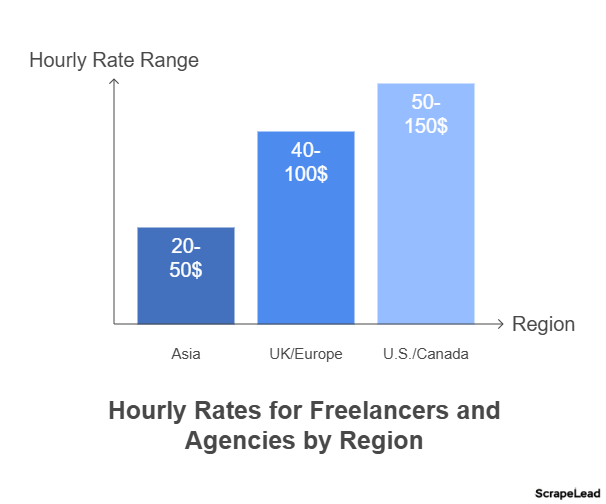
(Source)
Are Ad Costs the Same Everywhere?
Yes, platforms like Google Ads or LinkedIn Ads have similar ad prices around the world.
But in some lower-income markets like Asia or Eastern Europe, ad costs and rates of the agency are lower.
However, if you want to reach a big or global audience, then you’ll definitely need a bigger budget, no matter where you’re based.
(In short, use the US data as a guide, and adjust for local conditions as needed.)
Cost Per Lead by Channel
Here’s the breakdown of average cost per lead by channel:
| Lead Generation Channel | Average Cost Per Lead |
|---|---|
| Events and Trade Shows | $810 - $815 |
| Traditional Marketing | $615 - $625 |
| Public Relations | $290 - $300 |
| Video Marketing | $170 - $180 |
| Search Engine Advertising (PPC) | $110 - $115 |
| Content Marketing | $90 - $95 |
| Linkedin Advertising | $70 - $80 |
| Webinars | $70 - $75 |
| Referrals | $70 - $75 |
| Display Advertising | $60 - $70 |
| Social Media Advertising | $55 - $65 |
| Email Marketing | $50 - $55 |
| SEO | $30 - $35 |
(Sources: Congnism, emailtooltester)
Did you know you can actually purchase leads online? Yes, it’s right.
I’ve already compared 11 best platforms to buy leads.
Key Factors That Influence Lead Generation Costs
Industry and Targeting Complexity
The type of industry you’re in and who you’re targeting can affect your cost per lead.
For example, if you’re in a highly regulated industry, like healthcare or finance, it usually costs more.
Why? Because you need more specialized campaigns + research, and compliance.
Also, some industries are more competitive.
For example, getting a lead in the legal or finance industry can cost hundreds of dollars.
Why? Because of high competition + each client is super valuable.
On the other side, industries like e-commerce or hospitality have lower costs per lead.
In short, the more complex your audience or industry, the more you’ll likely spend.
Marketing Channels and Methods
The way you reach people makes a big difference in how much each lead costs.
Outbound methods like cold calls, paid ads, or events usually cost more.
Because they often need personalized outreach and need extra effort to get someone’s attention.
On the other hand, inbound methods like SEO, content marketing, or organic social media advertising are cheaper, but they take time to build.
In simple terms:
- Fast and direct = more expensive
- Slow and steady = cheaper, but takes time
Lead Quality
Not all leads are equal, and that also affects cost.
If you need;
- Just the name and email = pretty cheap
- High-quality leads (people who are ready to buy) = pretty expensive, takes more time and effort
Geography
Where you’re running your campaigns and where your team is located can really affect your lead costs.
The leads cost more in places like the U.S. or Western Europe, because of expensive ads and higher expectations of people.
As we mentioned earlier, labor costs vary, too.
If you hire marketers from North America, it can cost you around $50 – $150 per hour.
And if you hire marketers from Asia or Eastern Europe, then it can cost you around $20 – $50 per hour.
But keep in mind that ad platforms like Google and Facebook charge based on competition, not by location.
So, your ad costs might still be high, even if your team is based in a cheaper region.
Tools and Technology
The tools you use for lead generation affect how much it costs.
If you want to use premium and advanced tools like CRMs, email automation, and data platforms, then you have to pay more. (But it can help you a lot.)
But if your budget is tight, then you can use basic tools.
Remember:
- Better tools = more money, less work
- Cheaper tools = less money, more work
The choice is yours.
How to Reduce Lead Generation Costs
Talk to The Right People
Make sure your ads and messages are reaching the right audience.
Don’t waste your money on those people who are not interested in your offering.
Focus on the people most likely to say “YES” to your offering.
Narrow down your audience based on behavior, interests, or demographics.
Use AI Tools to Help
AI is a game-changer.
AI tools can:
- Find the right people to target
- Help you send better messages or emails
- Follow up automatically
In short, by using AI tools, you can save time, money, and get more efficient results.
Create Helpful Content
Good content attracts the right people.
Focus on SEO and write blogs, guides, or FAQs that answer real questions.
You can also make videos and share tips on social media.
Over time, this brings in free and organic traffic from Google and social media, and those people are more likely to become your customers.
Fix Your Landing Pages
Let’s say someone clicks on your ad and lands on your landing page, which is confusing or boring, people will leave immediately.
So, make sure your landing page:
- Looks good
- Loads fast
- Have a clear CTA (like “Sign up” or “Book a call”)
Good landing pages = more conversions = lower cost per lead.
Retarget Visitors
If someone visits your website but doesn’t sign up, don’t let them go.
Show them ads later on social media or Google to remind them. This is called retargeting.
It’s cheaper than finding new people every time.
Try New Things
Try different headlines, buttons, or pictures in your ads, landing pages, and emails.
Even small changes can improve your conversion rate and reduce your cost.
Keep what works best and drop what doesn’t.
Follow Up with Old Leads
Sometimes the best leads are the ones you already have, but they need just a little nudge.
Send them helpful emails or updates to remind them.
Use a Mix of Strategies
Don’t rely on just one method.
- Use content and SEO to bring people in
- Reach out directly with emails or LinkedIn
This combo works great together.
You don’t need a huge budget to get great leads, you just need a smart plan.
Looking to level up your lead generation?
Click here and select ‘Lead Generation’ to explore powerful strategies and expert guides.
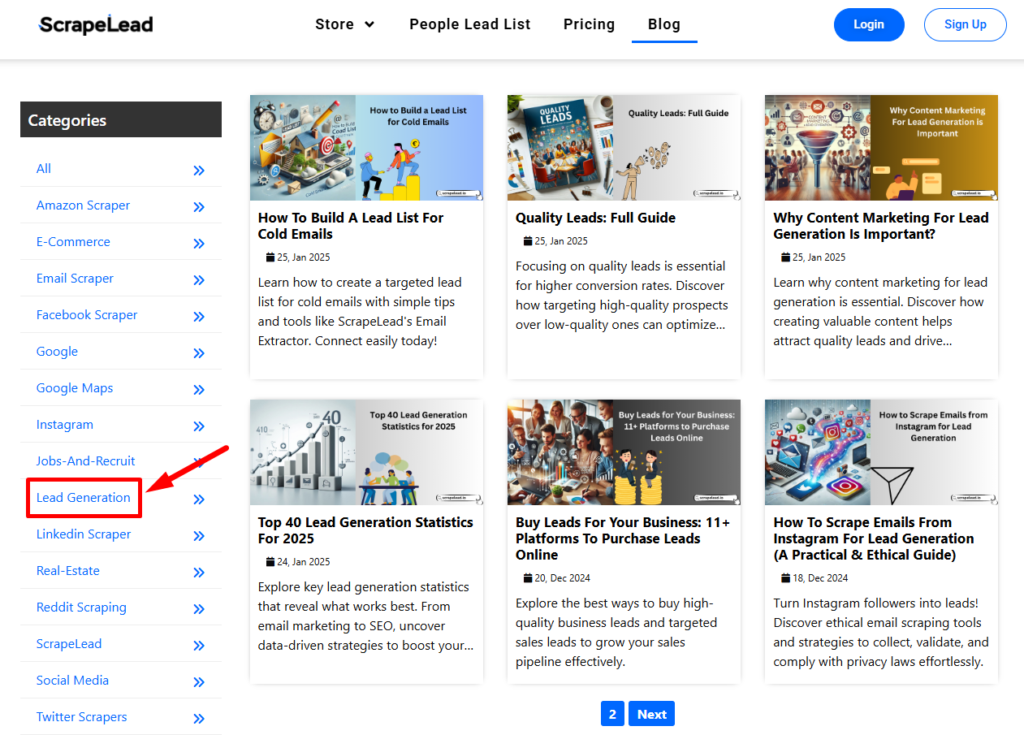
No fluff, just helpful guides to get more leads.
Final Words
At the end of the day, lead generation is not a one-time cost, but it’s an ongoing investment in the growth of your business.
Yes, the price of lead can vary a lot. Some industries pay $20 – $30 per lead, while others pay over $500.
Channels such as SEO and cold emailing are cheap, whereas trade fairs or premium B2B campaigns are expensive.
But keep in mind that:
It’s not about how much you spend, it’s about what you get in return.
For example:
- A $20 lead that never makes a purchase is pricey.
- But a $200 lead that turns out to be a loyal customer? Absolutely worth it.
So when you’re planning the lead generation budget for your business, think like this:
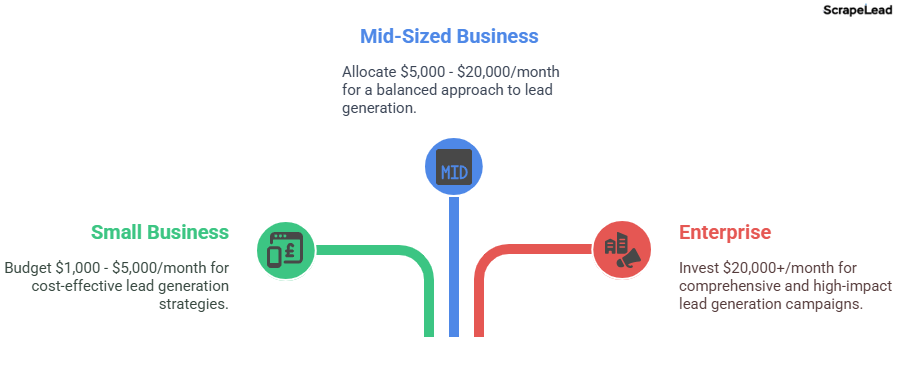
And of course, the actual number depends on:
- Your industry
- The channels that you use
- Your goal and team configuration
The goal is to focus on ROI, not just cost.
FAQs
Legal, software, finance, and oil and gas.
Between $420 – $450.
SEO, email marketing, and referrals.
Events, trade shows, and traditional marketing (TV, print).
In-house is costly, whereas outsourcing is flexible and cheaper (especially for small businesses).
$5,000 to $15,000+ per month.
$4,000 to $20,000+ per month.
Basic tools start at $10 – $30 per month, while advanced software can cost $800 – $10,000+ per month.
Related Blog

11 Real-World Use Cases of Web Scraping in 2025
Explore 11 powerful examples of web scraping and see how to use data to gain insights, leads, and a market edge in 2025.

Which Review Scraper Is Best for Your E-commerce Business?
Want a simple way to start scraping reviews? Learn how to grab real customer feedback and make smarter product decisions fast.

How to Scrape Social Media Without Coding (2025 Guide)
Discover how to collect social media data effortlessly with no-code tools in this 2025 guide.
